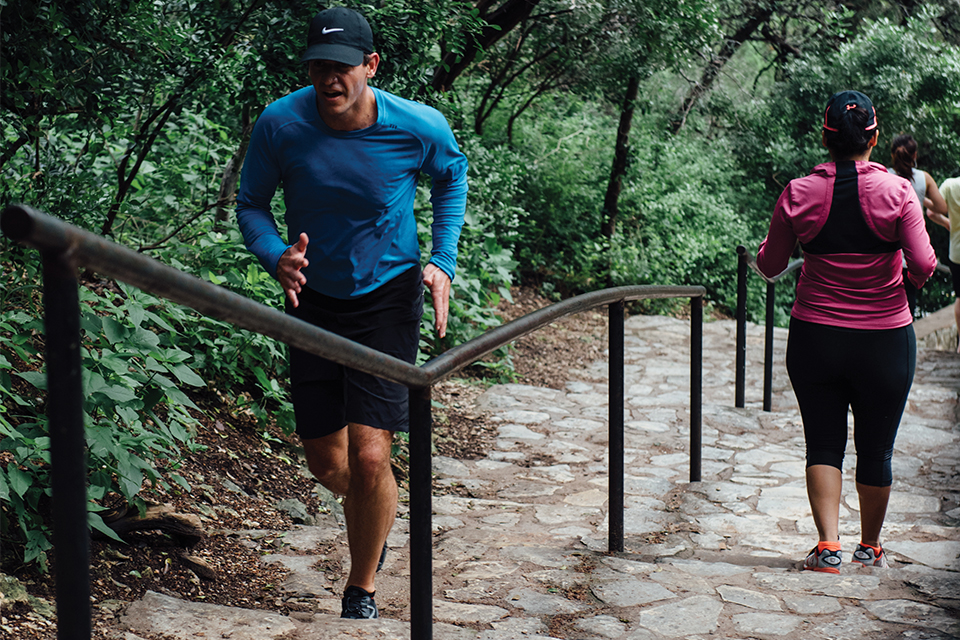Better Than a Stairmaster

For most of my life, climbing stairs was something to do only if the elevator was broken. But after deciding to participate in the American Lung Association’s Fight for Air Climb at Austin’s Frost Bank Tower a couple of years ago, climbing stairs became essential to my training. So I started looking for some to climb.
Unfortunately, stairs suitable for training are not as common or as well advertised as, say, the hike and bike trail around Lady Bird Lake. Most high-rise stairwells are locked up, as are the once-popular steps at UT’s Darrell K Royal—Texas Memorial Stadium. But if you look hard enough, you’ll find spots around town that are fit for a stair-climbing workout.
Mount Bonnell
Austin’s uber stair climb, Mount Bonnell tops out (after 105 steps) to some of the city’s best vistas of downtown and Lake Austin. “Mount Bonnell is one of my favorite [stair climbs] because of the view,” said Joe Berti, founder of Austin fitness marketing firm Sweti Services and lead trainer for the 2015 Frost Bank Tower climb boot camp.
Parking Garages
Ideally ones with open-to-the-public stairways. “You can run up to the top of a four- or five-story parking garage, then run down the stairs on the opposite end for recovery,” Berti said. “To get a little extra training, I have people carry 5 to 12 pound weights.” One of the best parking garages is at St. David’s South Hospital—it climbs seven floors (or 140 steps) above Ben White Boulevard, and you’re rewarded with unique skyline views at the top. In North Austin, try the garage at the Triangle. If you’re closer to downtown, try the one at the Long Center.
River Place Nature Trail
On the north side of Lake Austin, between the Pennybacker Bridge and Mansfield Dam, lies the River Place neighborhood. The River Place nature trail (featured in Austin Fit’s March issue) is a 3.5 mile track with more than 1,800 feet of elevation change. The steps are uneven—as they are constructed of railroad ties embedded in the earth—but the trail is shady and the scenery is captivating.
Mount Baldy
One of Wimberley’s signature landmarks, this outdoor staircase leading to the top of a “mountain” is composed of 215 stone steps. The park was recently slated to be sold to a developer until local residents rallied last year to raise funds to preserve it. Mount Baldy is one of the Hill Country’s most challenging climbs.
At Berti’s boot camp workouts, held on Saturdays during the two months leading up to the Austin Fight For Air Climb, participants run and walk up the Mount Bonnell steps. Some take six trips up and down the steps; others take 12 or more.
 The Frost Bank Tower is 660 steps high, so Berti recommends training at about twice that vertical distance. The typical Frost Bank Tower racer reaches the 31st floor in four to 10 minutes.
The Frost Bank Tower is 660 steps high, so Berti recommends training at about twice that vertical distance. The typical Frost Bank Tower racer reaches the 31st floor in four to 10 minutes.
Austinite Michael Doherty took home the first place trophy in the “extreme” category in 2013, completing two circuits of the staircase in 8 minutes 2 seconds. He ran his first “lap” in 3 minutes 45 seconds, riding the elevator down before starting his second loop.
Doherty got into stair climbing when he was training to climb Mount Rainier in 2009. Since then, he’s completed a dozen stair races—huffing up buildings from Houston to Las Vegas. He’s run up Chicago’s daunting 2,115-step Willis Tower twice and has been ranked in the nation’s top 50 climbers. “I’d like to see [the sport of stair climbing] grow, particularly in Texas,” Doherty said. “It gets so darn hot here. During summer, it’s nice if you can be inside and race.”
Stair climbing is definitely growing in popularity, in large part due to the 65-city-wide Fight for Air Climb fundraising series. The Austin branch of the climb has been held at the Frost Bank Tower each spring for the last six years. Jessye Padilla, spokesperson for the American Lung Association, said Austin’s event draws about 450 participants and 500 to 600 spectators. Fight for Air Climbs in other cities draw as many as 2,000 climbers, she said. “Some cities do two or three different buildings with different heights, which is something I’d love to do as the Austin skyline gets taller and taller,” she said.
Stair racing has active Facebook fan pages as well as national and world associations. The sport’s aficionados are drawn to the activity because it offers them an opportunity to get an intense workout that improves aerobic fitness, strength, and speed better than a lot of other activities. In addition to those training for tower races, triathletes, rowers, cyclists, and runners also prize the simple workout method. Doherty, for instance, worked out on the River Place nature trail this spring in preparation for a rugged rim-to-rim round-trip trek across the Grand Canyon.
With its taxing physical demands and hard-to-find training facilities, the sport of stair racing may seem like an unlikely candidate for mainstream athletic and fitness competition. But then again, there was a time when running marathons was regarded as similarly extreme.
Stair climb training packs a lot of work into a few minutes, making it an appealing option to the time-strapped exerciser. And training facilities are opening up all the time. “In Austin, there seems to be a tall building going up on almost every corner,” Berti said, “so I see more stairs in our future.”






